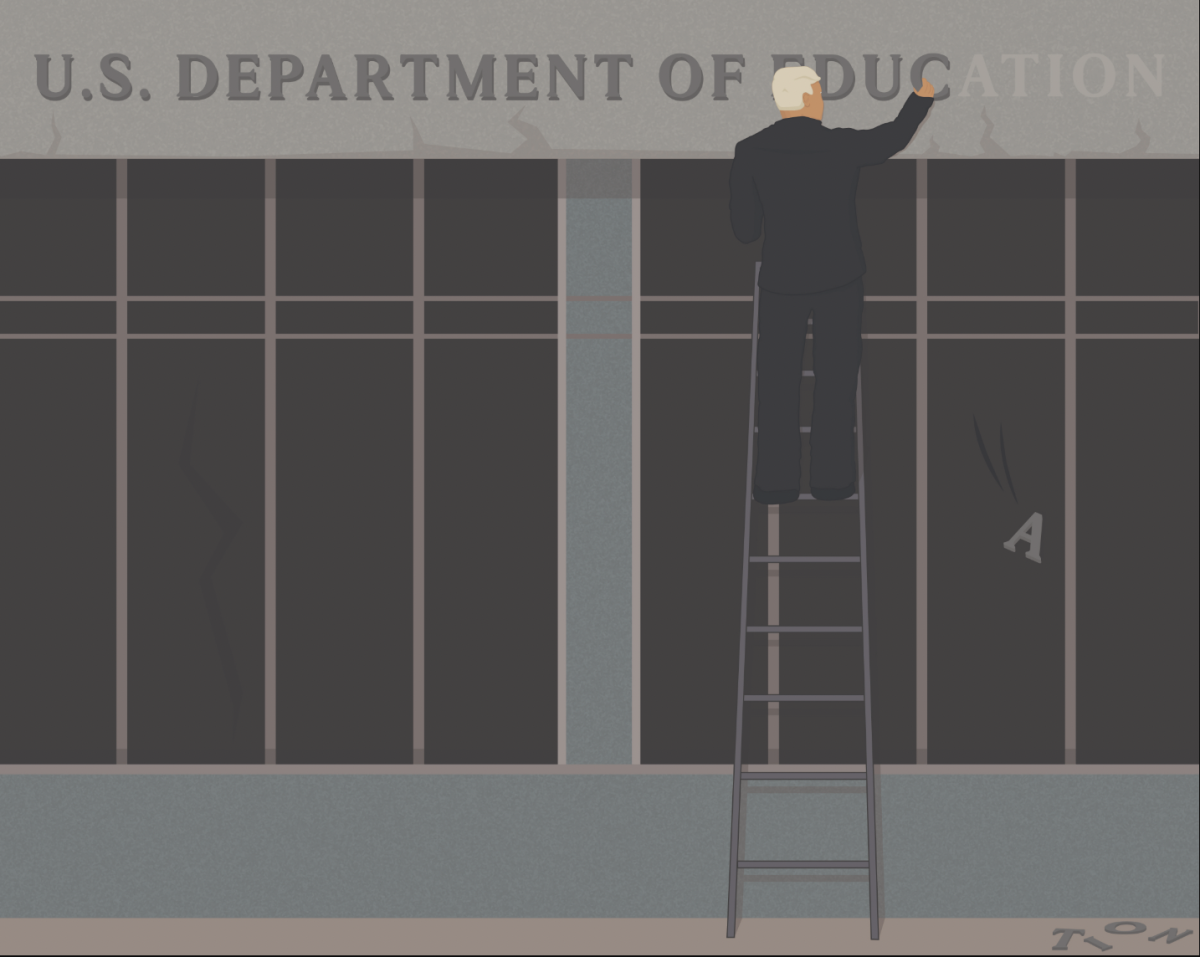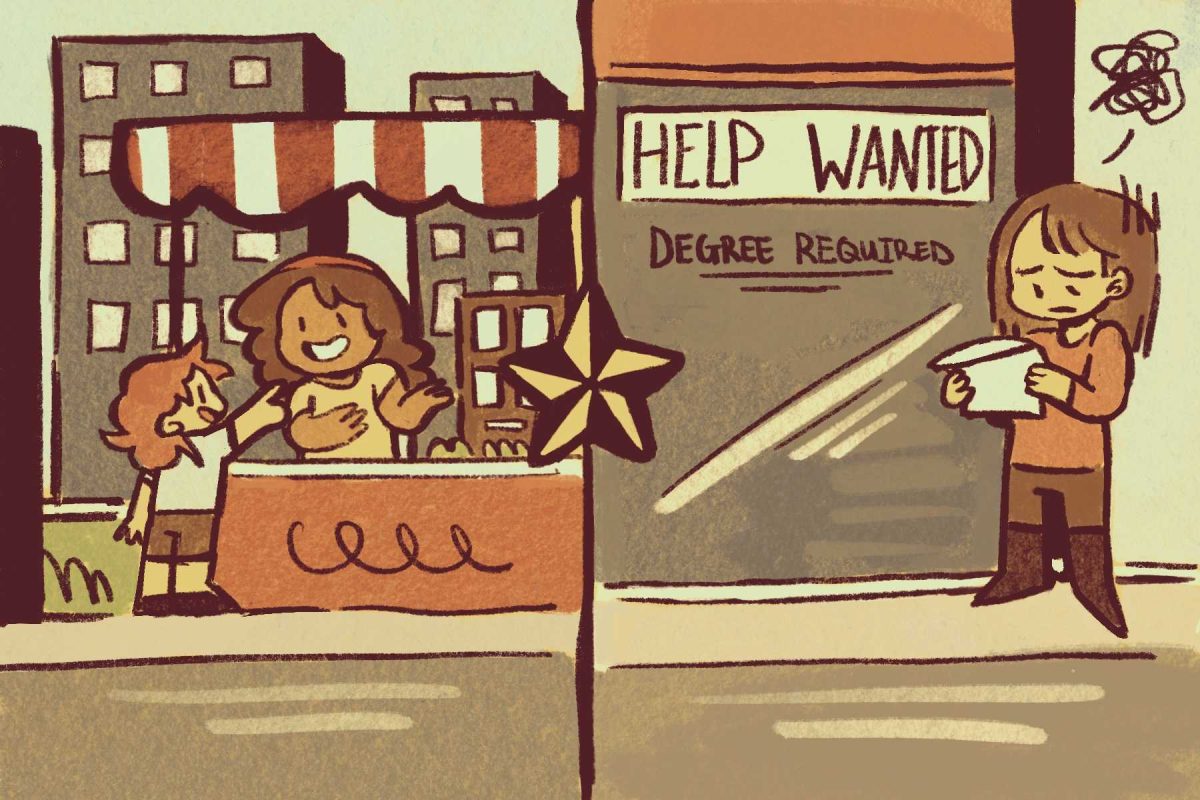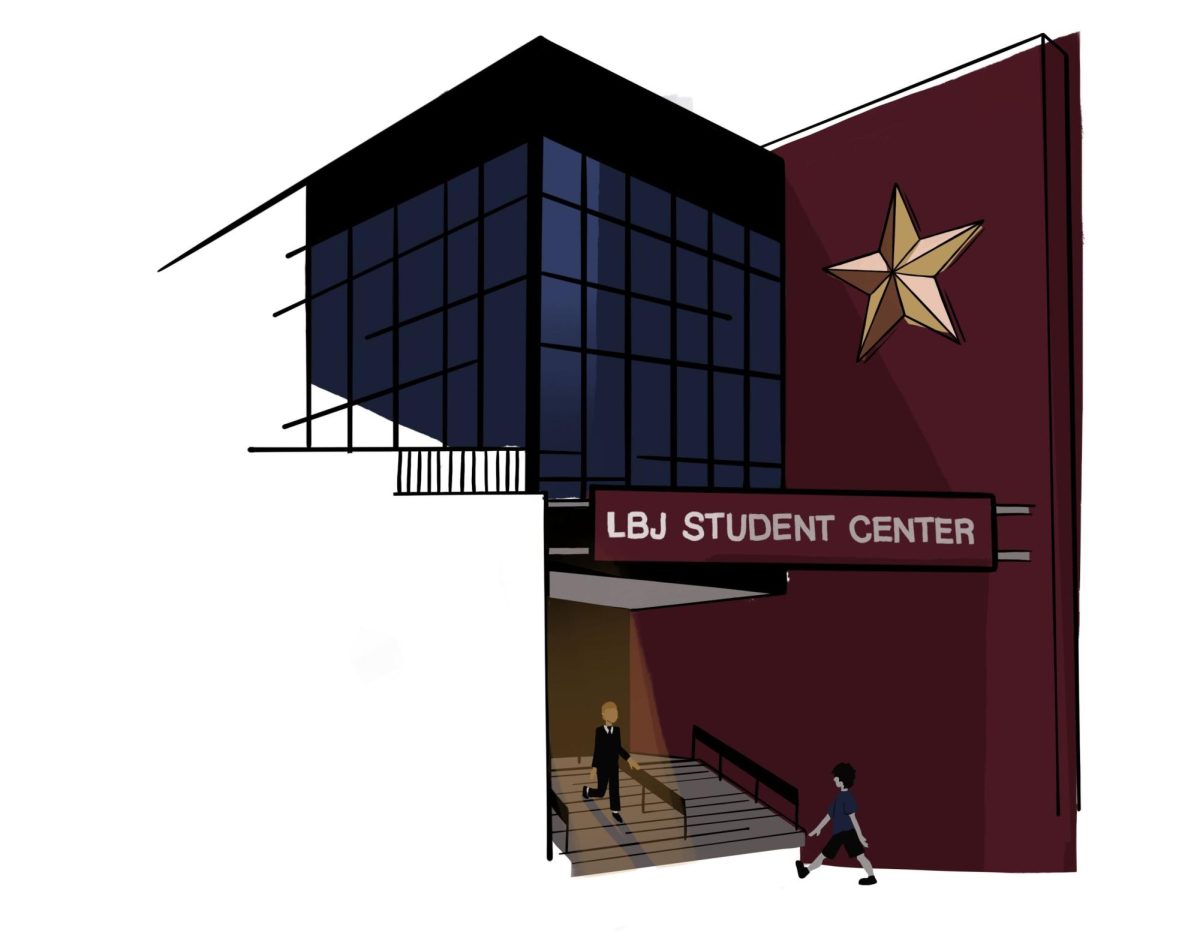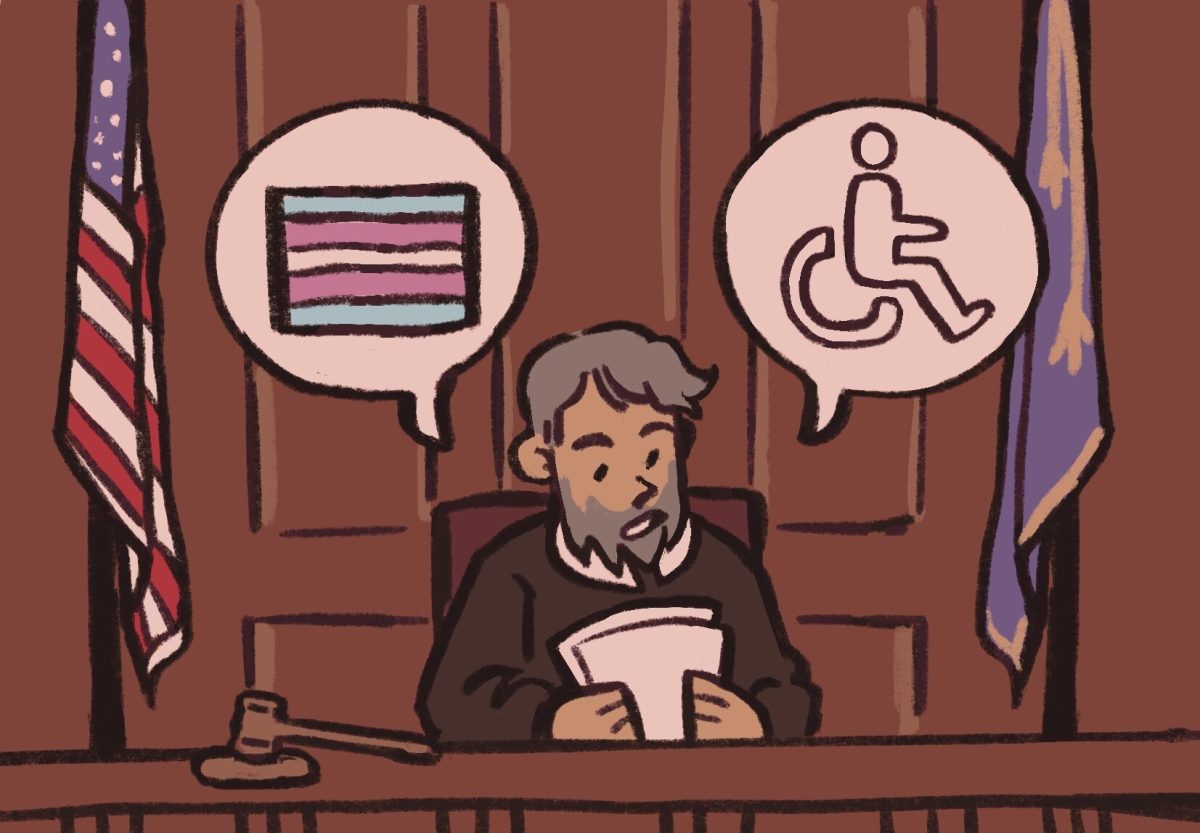Opinion: It’s too soon for 100% capacity in-person classes
Texas State students, faculty and staff are expected to return to full capacity in-person classes at the start of the fall 2021 semester. This news came from President Denise Trauth, who on April 7, sent out a campus-wide email announcing the university’s return to normalcy.
While the return to a pre-pandemic campus experience may come as a sense of relief for some students, others feel uneasy about sitting in a lecture hall surrounded by potentially unvaccinated and mask-free peers.
With the fall semester approaching, Trauth aims to provide all students, faculty and staff the opportunity to receive a COVID-19 vaccine, with a model projecting the administration of 1,500-1,800 doses a week.
Despite this hopeful projection, Texas State should not return to fully in-person classes for the fall semester. Instead, the university should opt for opening at 75% for the fall 2021 semester until more students are fully vaccinated.
Casey Dworaczyk, a theatre performance and production junior, says although she is excited for the fall semester, she feels nervous about the transition back to in-person classes and fears the return back may be too soon.
“I am really excited to return to 100% in the fall. I recently transferred in from a junior college, so spring 2021 was my first semester here at Texas State,” Dworaczyk says. “Honestly, this past semester was kind of a bummer. I am a little cautious about next semester, though; I’m not sure how it will work. I’m scared that we’re going to have another [COVID-19] outbreak if we rush in too fast.”
For other students, like Maksymus Emiliano, a mechanical engineering sophomore, Trauth’s announcement sparked a buzz of excitement.
“It’s good that students get to return,” Emiliano says. “I know that teachers had a difficult time transitioning to an online style, and that affected the students to where my chemistry class is failing, it seems.”
Despite Emiliano’s sense of hope, operating at 100% capacity still may be too soon since not all students are completely vaccinated. As of early June, an estimated 15-20% of the student body has received a vaccine from Texas State, and nearly 60% of the university’s faculty and staff have been fully vaccinated.
Additionally, the university is prohibited to mandate a campus-wide vaccination requirement due to Gov. Greg Abbott’s executive order.
Since the campus community is not fully vaccinated, there is a possibility of a COVID-19 outbreak with the return to fully in-person classes. Large universities that reopened in-person classes for fall 2020, such as Notre Dame and the University of North Carolina, experienced increases in positive COVID-19 cases. This forced both universities to close down all in-person classes for two weeks, causing a mass inconvenience for students and inciting a sense of hopelessness.
Should there be a COVID-19 outbreak on-campus that forces students to go back to online classes this fall, student morale will be highly impacted. Professors who prepared for in-person classes will be impacted as well, scrambling for cohesion like spring 2020.
Even in the Texas State community, just days before Texas State returned to in-person classes for fall 2020, there were parties off-campus with no social distancing or adherence to Centers for Disease Control and Prevention (CDC) guidelines. If students continue these risky parties, a COVID-19 outbreak is possible since not everyone is fully vaccinated.
In Texas, nearly 49% of the population 12 years and older is fully vaccinated. However, a recent study by the CDC indicates vaccine rates among younger people in all states are low. Despite low vaccination rates among young people, they can still catch the virus.
Furthermore, the delta variant of COVID-19 is of concern to the CDC. As of June 20, the variant accounts for 20% of new U.S. COVID-19 cases. This variant is highly contagious and more severe than the normal strain of COVID-19. However, health experts say the Moderna and Pfizer/BioNTech vaccines are nearly 90% effective at preventing illness of the delta variant.
Because young adults are less likely to get vaccinated, Texas State should slowly increase classroom capacity to 75% in order to avoid any potential outbreaks. Increasing the student population by 25% from last semester would still allow many students to return to campus. However, by implementing one more semester semi-hybrid, more students will have the opportunity to get fully vaccinated.
Furthermore, if the university continues its plan to return this fall, only 12% of classes will be online. Some students, like Emiliano, who live out of state, had the flexibility to attend classes virtually. Returning to classes in person takes away the flexibility of attending classes remotely.
“My dad lost his job during COVID. When the pandemic caused work to slow down, they had to lay him off. He had a job offer in Florida, so we went there,” Emiliano says. “I think I probably would stay [at home in Florida] because of the accessibility to classes online, but once everything goes back to in-person, [the accessibility will] disappear.”
Although students are fatigued by online learning, it is important to continue to practice the proper health and safety measures in order to ensure a safe transition back to normal. Operating campus at full capacity can provide a disastrous outcome that will put unvaccinated students in unnecessary danger and may regress all efforts made to keep the Bobcat community safe.
– McKenzie Siller is a biochemistry sophomore
The University Star welcomes Letters to the Editor from its readers. All submissions are reviewed and considered by the Editor-in-Chief and Opinion Editor for publication. Not all letters are guaranteed for publication.
Opinion: A return to face-to-face instruction is necessary for students
Education has drastically changed throughout the past year. After two and a half semesters of breakout rooms, internet crashes and accidental un-mutes, it’s become painfully apparent that online learning just isn’t the same as face-to-face instruction.
Texas State, like other colleges across the country, had virtually no time to prepare for the COVID-19 pandemic. The swift shift to online learning forced professors to quickly switch their curriculums to online formats, leaving our class qualities to suffer and faculty confidence in their course material to plummet.
When students were first introduced to this new way of learning, some students looked at the online situation and believed the alternative wasn’t so terrible.
Karim Cisse, a computer science junior, says at the beginning of the fall semester, he believed classes would be easier online.
“I thought online classes were going to be easy, and I was going to do really well,” Cisse says. “I thought I was gonna be able to stay in and have more flexibility in my life.”
Brenda Bradford, a social services junior, also shares Cisse’s thoughts. She initially thought the change would make classes more convenient online, especially without the commute from class to class.
“My initial thoughts were that it was going to be easy,” Bradford says. “I did like how I could just roll out of bed and not have to walk and get sweaty walking up Mount Everest to get to class.”
However, as Cisse and Bradford soon learned, while online classes at times seemed more relaxed, they lacked core characteristics of face-to-face classes, the first being human interaction.
“Every one of my classes [last semester] was online, and I felt like it wasn’t personal in any way,” Bradford says. “When the teacher wasn’t in the call, no one talked with each other. It’s pretty awkward.”
While students might have more contact virtually via online classes, office hours and meetings, the interpersonal interactions inside and outside of classes were lost. No longer were there seamless class discussions. Suddenly, interpersonal interactions had to be facilitated by the instructor on one single channel.
According to the National Communication Association, online education and the isolation it brings is detrimental to students. Traditional college connections can provide insight or networking opportunities, but these interactions aren’t feasible online. Simply put, online education lacks the social and academic interaction that leads to student success.
Additionally, the effectiveness of class curriculums was lost as schools shifted to online formats. Face-to-face teaching allows instructors to better gauge student understanding and interest, which leads to more participation and comprehension. In an online setting, ensuring that students are listening and retaining knowledge is difficult. There is less scrutiny when it comes to grading assignments, and the feedback is often more impersonal.
Virtual courses allow for only one type of learning, as well. There are no opportunities for hands-on work in an online lab, and material that requires being physically present in the classroom — like acting, filmmaking, public speaking and much more — cannot be taught solely through quizzes and online assessments. Face-to-face courses offer variety when it comes to the delivery of material, and clarity in how material is understood.
According to Cisse, face-to-face classes not only offer more hands-on learning, but create diverse learning opportunities for those who need more than a screen.
“It’s easier to get multiple ways of learning [in person]. You get auditory, visual and even one-on-one, if it’s a small class,” Cisse says. “And, depending on the professor, whenever they’re in front of people, you can tell they are into what they are teaching. You just don’t get that same experience on Zoom.”
Finally, when school work leaves the classroom and infiltrates a student’s home space, it can influence a student’s mental health. National Geographic warns of the dangers of “Zoom fatigue,” the mental strain of having to retain information delivered via online video calls. When we are being taught online or through Zoom, all our cues for non-verbal communication, like facial expressions and body language, are lost, and students place more emphasis on the individual words than the message or lecture itself.
Further, with there being only one audio channel and numerous participants, our attention is split. Thus, whenever students are in Zoom calls, they have to focus more to get less done. This strain of continuous partial attention is leading students to spend more time looking at their phones or even leaving calls rather than participating in class.
The Zoom platform also does not create the closed environment that a classroom does. For Cisse, being on Zoom entails having to actively minimize his distractions.
“There are a lot of distractions, and, over Zoom, you have to actively try and like, minimize those distractions,” Cisse says.
For Bradford, losing this classroom environment affects her mental state and social interactions.
“Being online over Zoom has given me anxiety when talking to people, for sure. You lose the little connections with people you use to have in a classroom,” Bradford says.
After President Denise Trauth announced on April 20 that most instruction for the fall 2021 semester would be delivered in person, concerns regarding COVID-19 inevitably arose. Yet, with increasing vaccine availability and decreasing reports of COVID-19 cases at Texas State, now is the best time to return to in-person classes. Face masks and social distancing are still important — and should be implemented. However, students need to return to a sort of normal, eventually, and that normal begins in the classroom.
It is a great idea to return to in-person learning, if nothing else, then for the sake of our education.
– Jesse Westburg is an electronic media junior
The University Star welcomes Letters to the Editor from its readers. All submissions are reviewed and considered by the Editor-in-Chief and Opinion Editor for publication. Not all letters are guaranteed for publication.




















